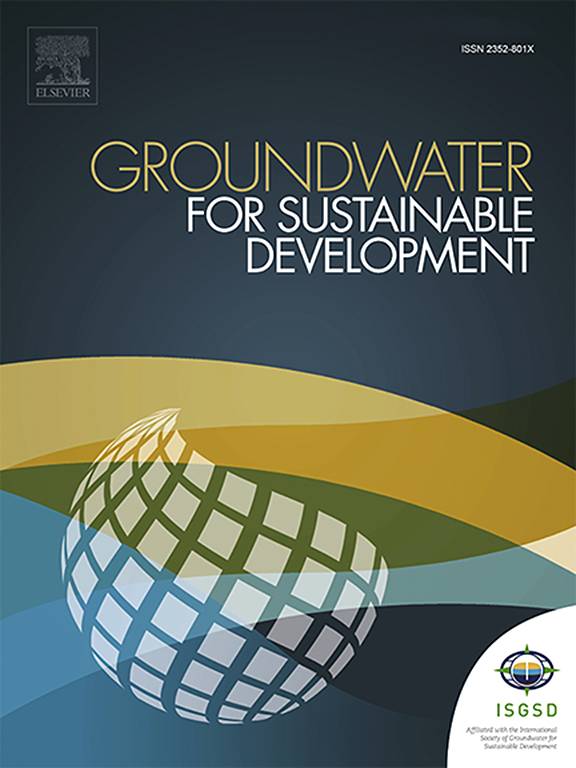整合水文地球物理和遥感数据增强裂缝性石灰岩含水层地下水潜力制图:以埃及贝尼苏韦夫东南部为例
IF 4.9
Q2 ENGINEERING, ENVIRONMENTAL
引用次数: 0
摘要
确定干旱地区的地下水潜力区对于缓解枯竭和加强水资源的可持续性和粮食安全至关重要。为了在这些地区为裂缝含水层制定有效的地下水管理框架,彻底了解场地的概念流模型对于确保灌溉用水的可持续性至关重要。识别地下水潜力区是地下水资源获取可能性较大的区域。本研究旨在利用地理信息系统(GIS)环境下的遥感(RS)和地表直流(DC)电阻率数据,建立一个综合框架,用于绘制裂缝性石灰岩含水层的gwpz。通过协调地表(降水率、线条密度、分水岭、排水系统、土地利用)和水文地球物理数据(层厚、含水层电阻率、覆盖层渗透能力和埋藏地质结构),这种整体方法旨在加强对石灰岩含水层水文地质框架的理解,包括地质特征、水文路径和水力特性。目前的研究结果主要集中在贝尼苏韦夫东南部地区,确定了地下水带,并提供了地下水运动和补给机制的见解。高度适宜区面积为53.71 km2(41%),适宜区面积为29.98 km2(23%),适宜区面积为43.30 km2(33%)。由此产生的框架显示出在类似干旱地区更广泛应用的潜力,简化地下水勘探,促进人工补给战略,并在全球范围内促进可持续水资源管理实践。最终,本研究不仅有助于地方决策者优化地下水利用,而且有助于实现与水安全和环境恢复力相关的可持续发展目标的国际努力。本文章由计算机程序翻译,如有差异,请以英文原文为准。

Integration of hydrogeophysical and remote sensing data for enhanced groundwater potential mapping in fractured limestone aquifers: A case study in southeast Beni Suef, Egypt
Identifying groundwater potential zones in arid regions is crucial in mitigating depletion and enhancing the sustainability of water resources and food security. To develop an effective groundwater management framework for fractured aquifers in these regions, a thorough understanding of the site's conceptual flow model is crucial for ensuring irrigation water sustainability. It is essential to discern the groundwater potential zones (GWPZs) that have a high likelihood of accessing groundwater resources. This study aims to establish an integrated framework for mapping GWPZs in fractured limestone aquifers by capitalizing on remote sensing (RS) and surficial Direct Current (DC) resistivity data within a Geographic Information System (GIS) environment. By harmonizing surface (precipitation rates, lineament density, watershed, drainage system, land use) and hydrogeophysical data (layer thicknesses, aquifer resistivity, overburden infiltration capacity, and buried geologic structures), this holistic approach aspires to enhance the understanding of hydrogeological frameworks in limestone aquifers, encompassing geological features, hydrological pathways, and hydraulic properties. Focused on the southeastern Beni Suef area, the current findings pinpoint groundwater zones and provide insights into groundwater movement and recharge mechanisms. The area highly suitable for artificial recharge spans 53.71 km2 (41 %), whereas the good and low-suitability zones cover 29.98 km2 (23 %) and 43.30 km2 (33 %), respectively. The resulting framework exhibits potential for broader applications in analogous arid regions, streamlining groundwater exploration, fostering artificial recharge strategies, and promoting sustainable water resource management practices on a global scale. Ultimately, this research not only aids local decision-makers in optimizing groundwater use but also contributes to international efforts to achieve sustainable development goals related to water security and environmental resilience.
求助全文
通过发布文献求助,成功后即可免费获取论文全文。
去求助
来源期刊

Groundwater for Sustainable Development
Social Sciences-Geography, Planning and Development
CiteScore
11.50
自引率
10.20%
发文量
152
期刊介绍:
Groundwater for Sustainable Development is directed to different stakeholders and professionals, including government and non-governmental organizations, international funding agencies, universities, public water institutions, public health and other public/private sector professionals, and other relevant institutions. It is aimed at professionals, academics and students in the fields of disciplines such as: groundwater and its connection to surface hydrology and environment, soil sciences, engineering, ecology, microbiology, atmospheric sciences, analytical chemistry, hydro-engineering, water technology, environmental ethics, economics, public health, policy, as well as social sciences, legal disciplines, or any other area connected with water issues. The objectives of this journal are to facilitate: • The improvement of effective and sustainable management of water resources across the globe. • The improvement of human access to groundwater resources in adequate quantity and good quality. • The meeting of the increasing demand for drinking and irrigation water needed for food security to contribute to a social and economically sound human development. • The creation of a global inter- and multidisciplinary platform and forum to improve our understanding of groundwater resources and to advocate their effective and sustainable management and protection against contamination. • Interdisciplinary information exchange and to stimulate scientific research in the fields of groundwater related sciences and social and health sciences required to achieve the United Nations Millennium Development Goals for sustainable development.
 求助内容:
求助内容: 应助结果提醒方式:
应助结果提醒方式:


